
2023 Pebble Beach AT&T Pro-Am - Volunteer Experience
On Sunday January 29, assistant superintendent Patrick Eden and I will be heading to California to volunteer at the Pebble Beach AT&T Pro-Am PGA golf tournament. This will be Pat’s first experience volunteering at a PGA tournament and the fifth time I have volunteered for this tournament. In previous years, both current assistant superintendent Thomas Gallant and former assistant superintendent Tom Morisson have also volunteered. The AT&T takes place over 4 days at 3 different golf courses, Pebble Beach, Spyglass Hill, and The Monterey Peninsula Golf Club. These three golf courses are all located very close to one another and all within the famous 17 Mile drive. The playing field for the tournament is divided into 3 groups. Each group plays each course once with the cut made after the third round. The final round is played only at Pebble Beach.
Pat and I will be volunteering in the Turf Department at Spyglass Hill. This will be a great opportunity for both of us to not only observe but be emersed in the agronomic operations of a PGA Tour event. We will have the opportunity to meet and work alongside PGA agronomists and rules officials as well as superintendent Bob Yeo and his staff at Spyglass. During our time at this year’s tournament, Pat and I will endeavour to share as much of our experience as we can. There is a chance that Pat and I will spend much of our time working together, but we may also have very different daily duties. In previous years I have been involved in mowing greens and fairways, tee set-up, raking bunkers, filling divots, and general course clean-up and prep. I have also worked directly with the PGA agronomist to collect daily greens data. This involves measuring speed, firmness, and moisture content of each green on the course two times per day. Data is collected first thing in the morning before play and again in the late afternoon after play has finished for the day. The data collected is measured against the players’ scores for that day to help determine if the greens are to fast or too slow or playing fair for the tournament. Because of the number of amateur golfers at this event as compared to a traditional PGA tournament, the PGA does not want the course to play too hard or it becomes too difficult for the amateurs and negatively affects pace of play. The greens maintenance program for the following morning is then adjusted based on what is deemed necessary to achieve the desired green speed. If green are too slow, they might be double cut or rolled the next morning or even between rounds. If they are too fast, they might only be mowed once the next morning or only rolled and not mowed at all. It is always an interesting discussion between the superintendent and the PGA as to which way they think they should go.
As the week unfolds, Pat and I will try to bring as much of the tournament as we can to you, from a turf point of view. We will find out what is in store for us at 6 am on Monday the 30th when we show up for our first shift. A typical day for us will start between 5 and 6 am and end around 5 pm. If at any time you have questions about our adventure or anything we post, please forward them to Avery Kinsella at the golf club and she will pass them on to us. We will respond as promptly as possible.
Stu Leachman
Senior Assistant Superintendent
DAY ONE
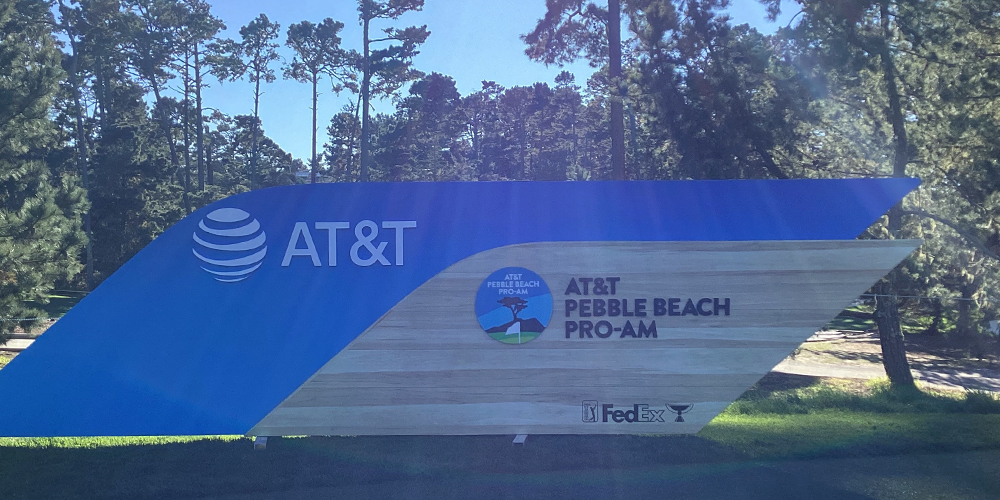
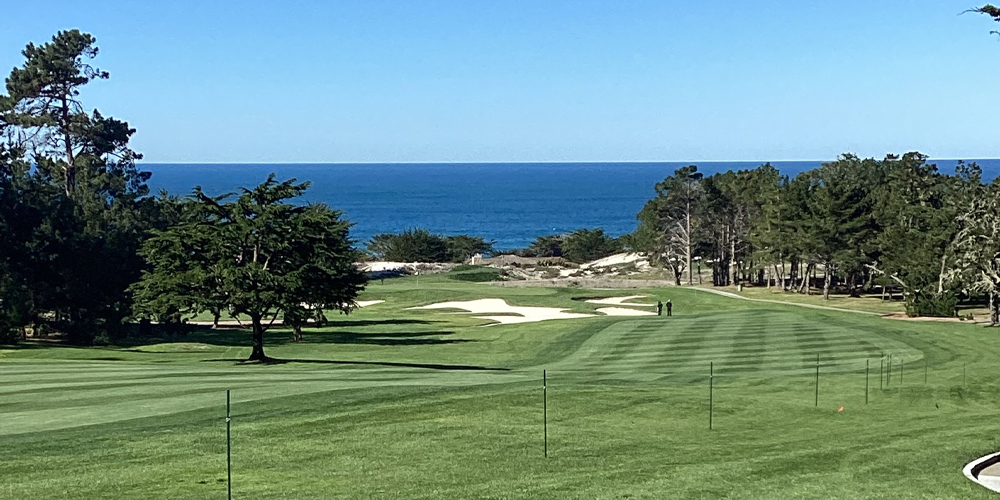
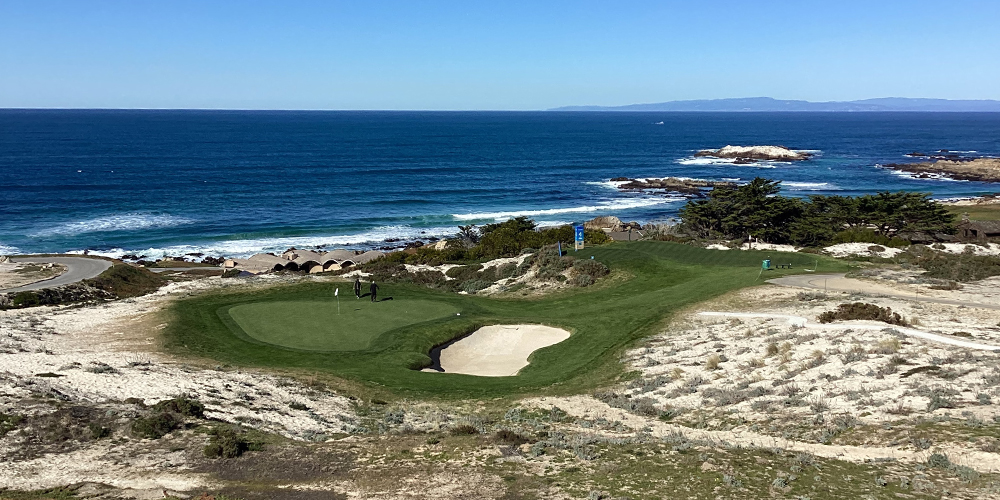
Hi everyone, our first day at Spyglass is in the books. After a chilly start to the morning, the sun came, and it was a great day. Pat and I will both being collecting data for the PGA this week. I described the process above. Pat is working with our old friend and former assistant superintendent Tom Morison. Tom has recently taken over as the assistant at the Surrey Golf Club in BC. I am working with a fellow by the name if Guillaume Drouet. Guillaume is from France and came all the way to California to experience his first PGA tournament. He is a Greenskeeper at Celtic Manor in Wales UK.
Spyglass Hills gets its name from the Book Treasure Island by Robert Lewis Stevenson. He got the idea for the book while living in Carmel, an area just down the coast from where the golf course is located. The local lore says he used to walk the coast from Carmel all the way to where Spyglass is to a hill where he could look through his telescope and see all the way to Santa Cruz. That hill became known as Spyglass Hill and the name found its way into the book. All of the holes on the course are named after places or people in the book. If you have ever been here and stood on the third tee, you would understand why the name is so fitting. It offers you an amazing panoramic view along the coast and out into the ocean.
Tomorrow we will begin our data collection first thing in the morning and then again after lunch. This will be the program for the week. The highlight tomorrow will be the start of the staff BBQ. Best guacamole you’ve ever had!
Stu Leachman
Senior Assistant Superintendent
DAY TWO
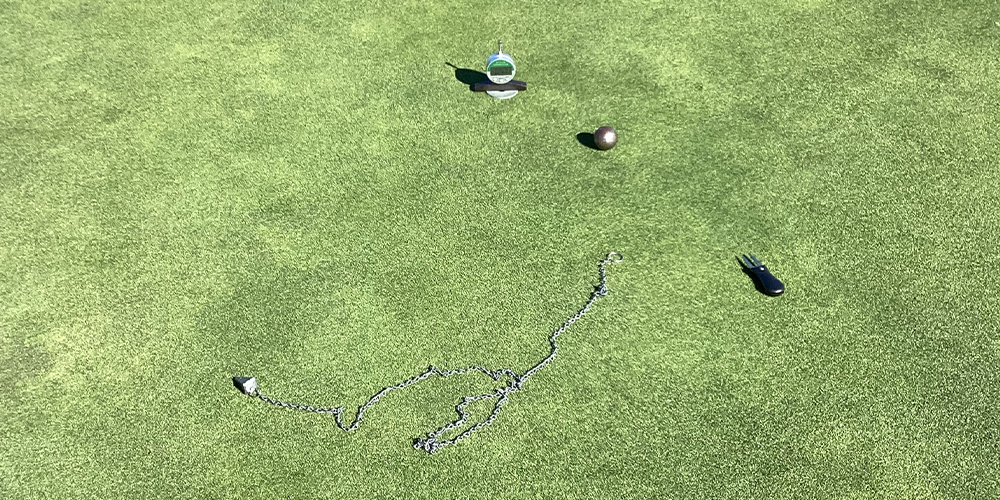
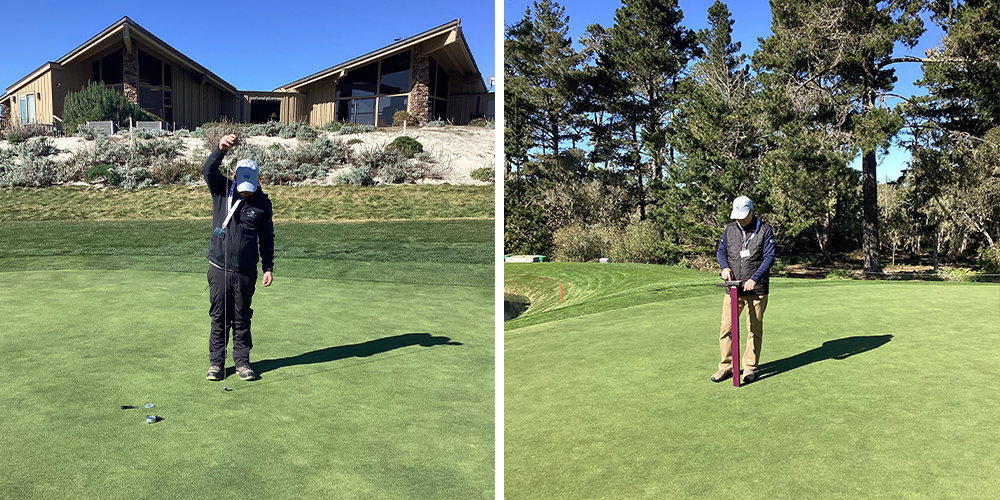
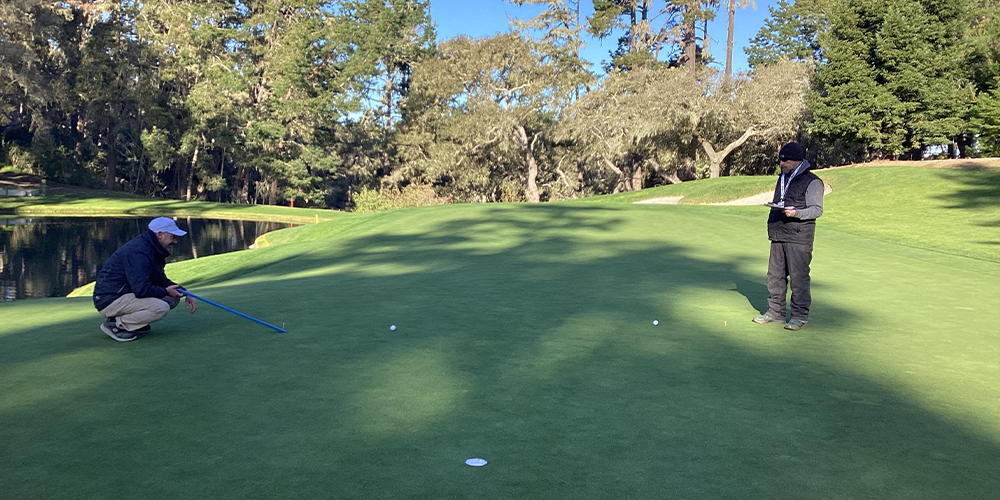
We had another great day at Spyglass. The wind was a little brisk but not a cloud in the sky (sorry). I thought I’d explain the data collection process we are doing here. As mentioned previously, it involves three steps. The first is measuring the moisture content of the top three inches of the green. We measure the top three inches only as water content within that layer can directly affect ball speed. The less water, the firmer the surface and thus the faster the green speed. It also means that ball marks will be shallower and balls will release more upon impact. To measure moisture we use a tool called a TDR. You may have seen us using this same tool at CountryHills on our greens. It works on the premis that water conducts electricity. Basically, the unit has two three-inch prongs that you stick into the surface of the green. The prongs are 1 inch apart. You then press a button that says read and it send an electrical current down one rod to be picked up by the other. You are then given a number between 0 and 99.9. The more water that is in the ground, the quicker that electrical current will travel between the two prongs. You are then given a reading between 0 and 99.9. The higher the number the more moisture in the ground. The more you use the TDR, the better grasp you can get on the health of your turf and what optimal moisture levels are for playing and for health. Attached are a few pictures of me using the TDR this afternoon on the 7th green at Spyglass.
The second set of data we collect is firmness. This measures how soft or hard the green is. For the tournament, they want firm greens but not unrealistic. As mentioned yesterday, the greens still need to be fair for the amateurs. To measure this we use a very rudimentary technique. We drop a round metal ball from a consistent height on every green and measure the depth of the indent it makes. We have a chain with a plum bob on the end that is 6 feet long. This keeps the drop distance the same. We hold the chain up so the plumb bob tickles the turf and drop the ball. We then use a plunger device to measure the dent in increments of inches. A measurement of 250 for example would be a quarter of an inch. We take three measurements per green, front, middle, and back. (sorry, also should have mentioned we take 12 moisture readings per green). We then obviously fix the dent like you would fix a ball mark. Attached are some pictures of my friend Guillaume from today.
The last thing we do is measure green speed. Many of you may also have seen Scott doing this at Country Hills. This involves using a stimp meter to roll a ball across a level area of a green and then measuring the distance it rolls. Simple enough if you can find a flat spot. At Spyglass there are only 10 greens that have an area flat enough and long enough to accurately measure green speed. You essentially need about 15 feet of flat area to be able to stimp. The idea behind the stimp meter is similar to the plum bob for firmness, it gives you a consistent velocity on every green to roll a ball. The ball needs to roll in a straight line with no more than 4 inches of break otherwise it can affect the reading. To measure green speed, we mark two spots on a green approximately 12 feet apart. We then roll two balls in one direction and measure the distance of the average of the two balls. We then roll the two balls the opposite direction and again measure the average of the two. We then take the average of the two readings as the green speed. We use the same spot each day. And, no we are not allowed to share the manners with anyone until after the tournament. Attached are a few pictures of Pat and Tom stimping 12 green.
I know that’s a fair bit of information but hopefully it gives you an idea of what we are doing. It takes between 3 and 4 hours to collect all the data from all the greens 1 time. Data is also collected at Pebble Beach and Monterey Penn CC. The three courses are compared to try to get them all playing similar from day today.
Stu Leachman
Senior Assistant Superintendent
DAY THREE
Well, it was another great day in California today. Good weather and good food. Today was another day of data collection with a couple of twists. The first was our interaction with a fellow named Jim Abati. Jim is the PGA agronomist who oversees this tournament. He is responsible for attempting to get the greens at all three courses in this tournament to play the same. I have worked with Jim each year I have been volunteering here, however this was Pat and Tom’s first chance to work with him. Jim is an interesting guy with an interesting job. He is more than happy to chat with you about the tour and how the agronomy program within the PGA tour works, something Pat and Tom took advantage of. Also today, Tom and Pat were featured on the Pebble Beach Instagram account. They are part of a post that shows some of the tournament prep. We were not aware this was happening until another superintendent who works in Hawaii and is a friend of Spyglass superintendent Bob Yeo sent Bob a text to compliment Bob on the course. Celebrities in the making.
Tomorrow will be an interesting day. It is the first day of tournament play which will see another 30 volunteers join us at Spyglass. It also means a 5 am start time for the next three days and let me tell you, Tom, Pat and I are super excited about that.
Stu Leachman
Senior Assistant Superintendent
DAY FOUR
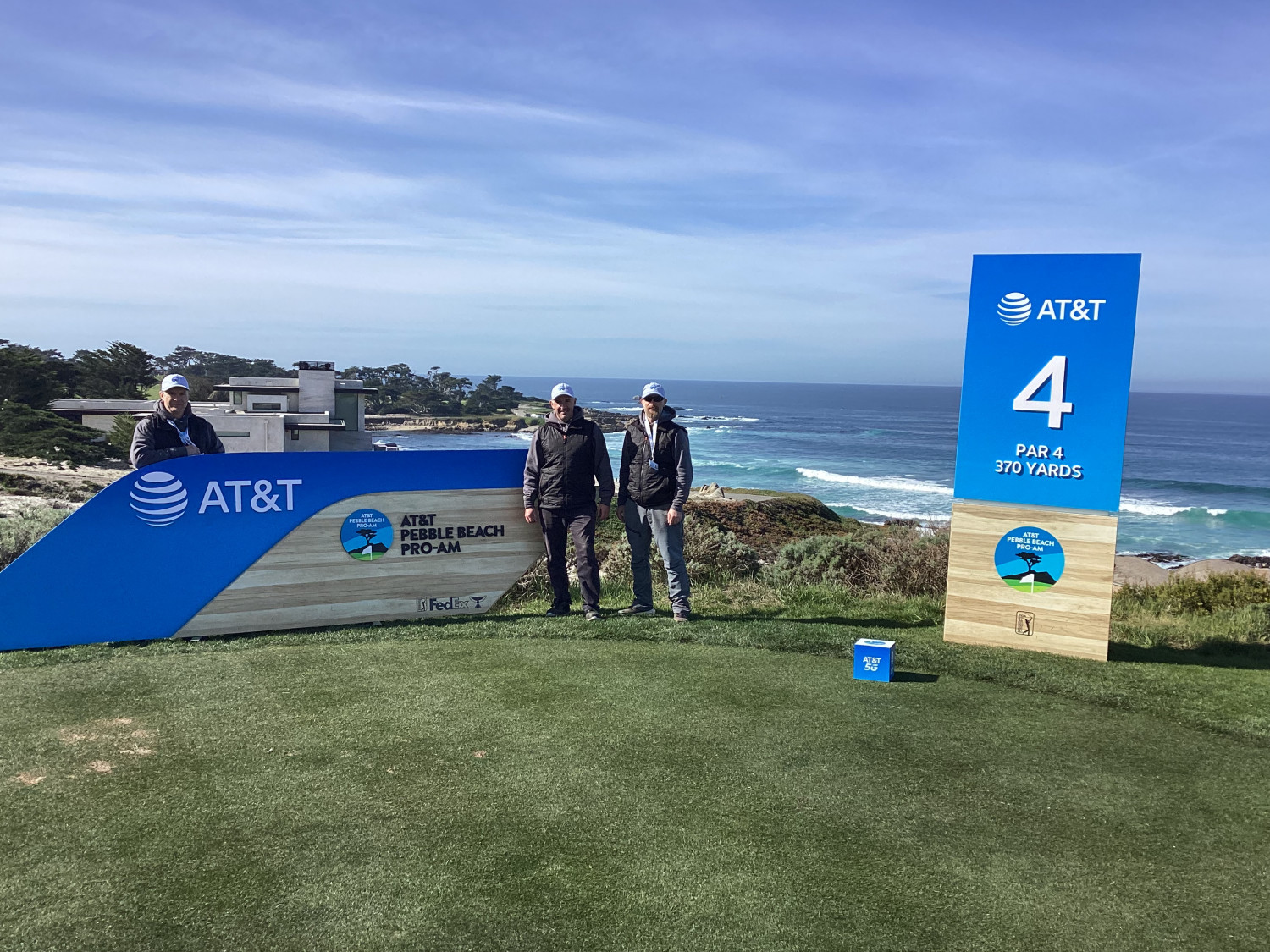
Well, it was another great day in California today. Good weather and good food. Today was another day of data collection with a couple of twists. The first was our interaction with a fellow named Jim Abati. Jim is the PGA agronomist who oversees this tournament. He is responsible for attempting to get the greens at all three courses in this tournament to play the same. I have worked with Jim each year I have been volunteering here, however this was Pat and Tom’s first chance to work with him. Jim is an interesting guy with an interesting job. He is more than happy to chat with you about the tour and how the agronomy program within the PGA tour works, something Pat and Tom took advantage of. Also today, Tom and Pat were featured on the Pebble Beach Instagram account. They are part of a post that shows some of the tournament prep. We were not aware this was happening until another superintendent who works in Hawaii and is a friend of Spyglass superintendent Bob Yeo sent Bob a text to compliment Bob on the course. Celebrities in the making.
Tomorrow will be an interesting day. It is the first day of tournament play which will see another 30 volunteers join us at Spyglass. It also means a 5 am start time for the next three days and let me tell you, Tom, Pat and I are super excited about that.
Stu Leachman
Senior Assistant Superintendent
DAY FIVE

It will be a short but sweet entry tonight. Today was basically a repeat of yesterday. It was a day of yet more data collection in the morning and afternoon. We had some rain this morning which, as you can imagine, was not much fun to work in. The crowd at Spyglass was much smaller today with the majority of celebrities playing at MPCC. After todays shift, all the volunteers were treated to dinner at a local pizzeria in Monterey called Gionni’s. This has been a tradition each year I have volunteered. I highly recommend it if you ever visit. Tomorrow is the last day of the tournament at Spyglass. The final round on Sunday is only played at Pebble Beach. Pat and I will have our last data collection shift in the morning then we will help return the golf course to its normal set-up for public play on Sunday. If the weather holds, hopefully, that public play will also include us!!
It’s currently 2 pm at Spyglass and play has been suspended due to wind. Pebble Beach and MPCC at both experiencing 30 to 40 mph winds which is essentially blowing players balls off of the greens on the holes that are along the coast on each course. MPCC seems to be a little worse. If you are watching on tv, they are currently talking about the weather and how play is impacted. Typically we would be heading out on the course right now to tear down the tournament and set up for public play tomorrow, but we are still in holding pattern. When play was called we went out and collected the tee blocks and flags as they are popular targets for people to pick up and walk off with. We have now just returned from putting everything back out on the course. While certainly not official, we are expect that they will not resume play today due to weather meaning we will be back tomorrow to help set up the course again to finish todays round first thing tomorrow. Time will tell I guess. Attached is a picture of the 11th hole at Spyglass with the Goodyear Blimp in the background. If time permits I’ll post again later today, but it’s currently shaping up to be along day for us.
Stu Leachman
Senior Assistant Superintendent
DAY SIX
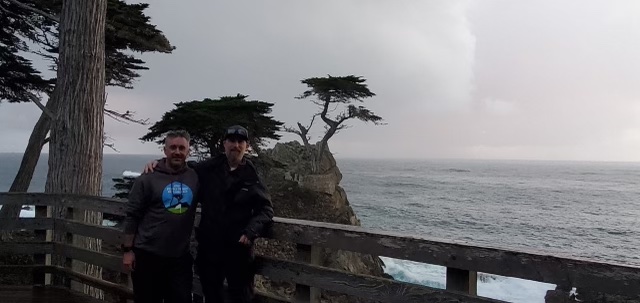
Evening folks. Or, at this point, good morning as it’s likely Monday morning when you read this. This will be the final post for the 2023 AT&T blog. We were back at the golf course this morning at 5 am to set up the course one last time. After the suspension in play yesterday, players had up to 13 holes to finish today. Most of the volunteers left Monterey yesterday evening as they booked travel arrangements in anticipation of the tournament wrapping up at Spyglass yesterday as it traditionally does. Instead of 30+ volunteers, we had 13 today. The golf course also scheduled fewer staff expecting the tournament to finish on schedule. The decision to suspend play yesterday was made entirely by the PGA leaving Bob and company to find as many bodies as possible to set up an 8 am shotgun. Once that mission was accomplished, it was again a waiting game to see if the weather would hold long enough to allow play to finish, which it did. The final round was started at Pebble Beach at 2 pm today and will be completed tomorrow. Once play was competed at Spyglass, the course was quickly set up to accommodate public play tomorrow morning. At about 11:30 this morning, our volunteer duties officially came to an end. We were then given the opportunity to play Spyglass in tournament conditions and with tournament pins. I won’t share any scores but needless to say a three month break between rounds doesn’t really help in this situation. There is a solid $100 worth of golf balls throughout the course courtesy of the three of us. There were some great holes and some not so great ones. But it was an opportunity none of us would pass up no matter what we scored. After the round we drove to the Lone Cypress lookout for a photo opportunity and a last visit to the sea side. Tomorrow we will pack up and head home. Thanks to those who have read the blog. If you have any questions about our experience, please drop by the shop any time, Pat and I would be more than happy to talk about it. Thanks also to the club and Scott MacArther for supporting our adventure.
Stu Leachman
Senior Assistant Superintendent
